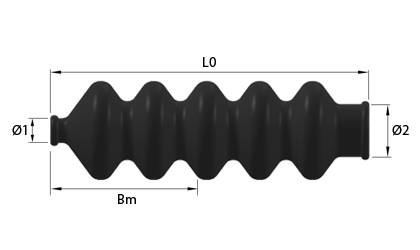Rubber bellows

Rubber bellows for gas springs - Protects against dirt.
Rubber bellows are stock items and are available for fast delivery.
Our rubber bellows have been developed mainly for our gas springs. However, they can also be used for other purposes. The rubber bellows are secured with a couple of strips, which prolongs the service life of the piston rod and thus also of the gas spring. The material can tolerate UV, oil, etc. If a gas spring is mounted in a dirty environment, it will always be a good idea to protect it from dirt and grime by using rubber bellows.
- BEL-10-400In stock: 268Ø1 - Piston Rod diameter (in) 0.3937Ø2 - Tube diameter (in) 0.8661L0 - Unloaded length (in) 21.6535Sn - Maximum travel (in) 15.7480Bm - Loaded length (in) 7.0866Suitable for stroke 290mm
300mm
350mm
400mmMaterial NBR
Rubber bellows are made from NBR rubber, which is resistant to UV light, salt and oil. Theoretical operating temperature between -20 °C to +60 °C.
The L0 measurement (unloaded length) is for guidance only. The rubber bellows by design can be pulled and pressed, and so change length. Variations in the L0 length have no impact on the usefulness of the bellows.
The bellows should not scrape/press against any other object, as wear will then cause the bellows to break.
When fitting bellows, use the length of the compressed bellows. This length is given in our table (Bm).
The bellows must be fitted before the end fittings are fitted to the piston rod.
The bellows are primarily designed for gas springs with threads, but can also be fitted to gas springs with welded loops.
The bellows must be fitted to the cylinder X number of mm (Bm) from the end of the cylinder, where the piston rod emerges.
- There is a line marked on the cylinder X number of mm (Bm) from the end of the cylinder, where the piston rod emerges.
- The bellows are guided with the largest diameter down over the piston rod and over the cylinder towards the line.
- The bellows are secured to the last piece of rubber on the cylinder using the strip provided.
- The bellows are secured to the piston rod using the strip provided on the last piece of rubber when the end of the rubber is just under the thread.
- Cut off the remainder of the strip.



